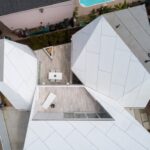Use IIW Block for shear wave distance calibration, Building structural steel welds, Threaded pipe, Ductwork fittings
How to Use IIW Block for Shear Wave Distance Calibration?
19 Oct 2022
Introduction
Shear wave mode inspection can be used on a wide range of welds in structural steel and cast iron and through transitions between different materials, as with welds over or under threaded pipe or fittings within the ductwork. You can also use shear wave mode to verify already installed welds and past production defects.
IIW blocks are widely used by inspection companies worldwide and are an acceptable solution for Shear Wave Inspection of metal plate welds.
The International Industrial Inspectors Working Group (IIW) published a standard for using blocks of insulating material to calibrate shear wave distance instruments. This article describes how IIW-type blocks are positioned and used and how they are used to calibrate the instrument.
1. What is IIW Block in Ultrasonic Testing?
IIW-type blocks are calibration blocks made of cast steel only. They are special blocks with different angles on each side made by Calibration Block Manufacturers. IIW type blocks are used to calibrate instruments for angle beam and normal incident inspections. Blocks used for normal incident inspections have one angle only and can be used in shear wave mode. Blocks used for angle beam (SAW) inspection have two angles for the same side of the block and can only be used in normal incident inspection mode. The calibration is achieved by measuring the actual shear wave distances with the block and comparing them with the calculated distances from a theoretical model.
Using an IIW block ensures that your angle beam inspection equipment is calibrated correctly and your normal incident inspection equipment. This, in turn, will lead to accurate measurement results for all sizes of welds.
2. What is Shear Wave Distance Calibration?
Shear Wave Calibration is a procedure used to calibrate the angle beam (SAW) distance instrument for various welds with a normal incident inspection.
During shear wave calibration, a steel slab (raw material) is cut into pieces of equal length. Each piece of raw material is placed on one side of an IIW-type block, and each set of two pieces is placed on another.
The principle that determines how much each piece differs from others is called cross-sectional variation. Each set of two pieces is registered in the encoder of the shear wave distance instrument. This also ensures that all measurement results are identical.
The measured wavelengths (WL) equal the displacement of each pair of pieces divided by the length and converted into decibel (dB).
3. How to Use IIW Block for Shear Wave Distance Calibration?(Procedure)
You need the following equipment for shear wave distance calibration:
- Shear wave calibration block
- IIW type block
- Specially made weld plate with defects for testing
- Transducers for shear wave calibration
- Ultrasonic flaw detector to display the readings
The procedure
- Hook the transducer on the shear wave block. Make sure there is enough coupling on the transducer and the shear wave wedge for more precise results.
- Attach the transducer with the shear wave block coupling to the ultrasonic flaw detector and adjust the parameters for shear wave calibration.
- After setting up the transducer and the flaw detector, you need to out a coupling on the IIW block for the shear wave block to land on. This is where you are going to test for the shear waves. The IIW block has two diameters, one with 4″ from the 0 point and the other 1″. This will provide for the 4″ measurement and 9″ measurement.h
- Place the shear wave block on the 0 point of the IIW block and observe the readings on the flaw detector. Here is where you will notice two signals on the flaw detector. One signal will be at around the 4″ mark and the other around the 9″ mark. Calibrate your flaw detector so that you accurately achieve the 4″ and 9″ marks on the flaw detector.
- After this calibration, you can use the specially made weld plate with defects to check if your law detector has been well-calibrated. This is because the specially made weld plate has known defects, so it’s easy to cross-reference the readings with the actual readings of the weld plate defects.
Use IIW Block for Shear Wave Distance Calibration Conclusion
After the shear wave block is calibrated and you have used it to calibrate your angle beam equipment, you can now use it to check all angle beam welds. If you want to purchase quality IIW Blocks for Shear Wave Distance Calibration, NDT-KITS covers you.
We are perfect for angle beam ins and ultrasonic flaw detection. All of our shear wave blocks are available in different modules and calibrations. We also have alternative transducers for angle beam, normal incident inspection, and intuitive, real-time data display for all welds.
Comments on this How to Use IIW Block for Shear Wave Distance Calibration? are welcome.
Building Articles
Contemporary Property Designs – recent architecture selection from e-architect below:
Aquabocci’s Designer Threshold Drainage
Autonomous WorkPod Backyard Home Office
Benefits of BIM in construction
Building a new home? Custom vs Modular
Architecture Posts
Architecture Designs
Madrid-Chamartín station, Madird, Spain
Design: UNStudio, with b720 Arquitectura and engineers Esteyco
Madrid-Chamartín: Clara Campoamor Station
Comments / photos for the How to Use IIW Block for Shear Wave Distance Calibration? page welcome.






